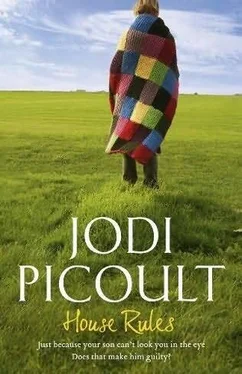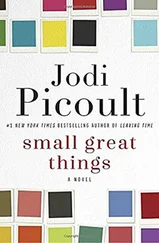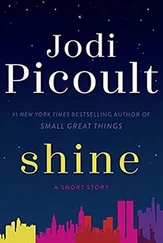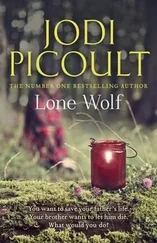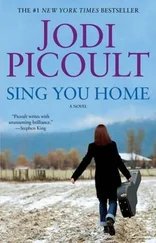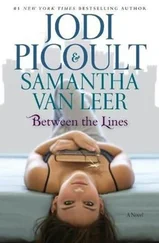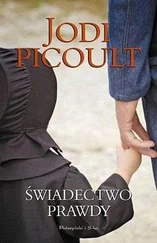“How do you make the comparison?”
“We look at specific areas and find patterns-deltas, whorls, arches, loops-and the core, the centermost part of the fingerprint. We make a visual comparison between the known fingerprint and the unknown one, looking for general shapes that match, and then we look at more specific details-ending ridges, or bifurcations where one line might split into two. If approximately ten to twelve similarities occur, a person trained in fingerprint identification will be able to determine whether the two fingerprints came from the same individual.”
The prosecutor enters into evidence a chart that shows two fingerprints, side by side. Immediately, Jacob sits up a little straighter. “This fingerprint on the right was found on the kitchen counter. The one on the left is a known sample taken from Jacob Hunt during his arrest.”
As she walks through the ten little red flags that show similarities between the prints, I look at Jacob. He is grinning like mad.
“Based on your comparison, did you come to a conclusion?” Helen asks.
“Yes. That this was Jacob Hunt’s fingerprint in the kitchen.”
“Was there anything else of note during your processing of the house?”
Marcy nods. “We found a kitchen window screen that had been cut from the outside, and the sash jimmied and broken. A screwdriver was found in the bushes below the window.”
“Were there any fingerprints on the sash, or on the screwdriver?”
“No, but the temperature that day was extremely cold, which often compromises fingerprint evidence.”
“Did you find anything else?”
“A boot print beneath the windowsill. We made a wax cast of the print and were able to match it to a boot on the premises.”
“Do you know who that boot belonged to?”
“Mark Maguire, the victim’s boyfriend,” Marcy said. “We determined that these were boots he kept at the house, since he often stayed there overnight.”
“Did you find anything else in the house?”
“Yes. Using a chemical called Luminol, we found significant traces of blood in the bathroom.”
Jacob writes a note on the pad and gives it to me:
Bleach + Luminol = false positive for blood.
“At some point did you receive a 911 call from the victim’s cell phone?” Helen asks.
“Yes. Early on January eighteenth, we responded to a culvert approximately three hundred yards from the home where Jess Ogilvy had been house-sitting, and found the victim’s body.”
“What was the position of the body?”
“She was propped up with her back against the cement wall, and her arms were folded in her lap. She was fully clothed.”
“Was there anything else noteworthy about how the body was found?”
“Yes,” Marcy replies. “The victim was wrapped in a distinctive, handmade quilt.”
“Is this the quilt that you found with the victim that day?” the prosecutor asks, and she offers Marcy a bulky roll of fabric in all the colors of the rainbow, the pattern marred by dark brown areas of dried blood.
“That’s the one,” Marcy says, and as it is entered into evidence, I can hear Emma draw in her breath.
Helen thanks her witness, and I stand up to cross-examine. “How long have you been a CSI?”
“Four years,” Marcy says.
“So not that long, then.”
She raises a brow. “How long have you been a lawyer?”
“Have you seen a lot of dead bodies at crime scenes?”
“Fortunately, not as many as I would if I worked in Nashua or Boston,” Marcy says. “But enough to know what I’m doing.”
“You said that you found a fingerprint at Jess Ogilvy’s house, in the kitchen, that belongs to Jacob.”
“That’s right.”
“Can you say that the presence of that fingerprint identifies him as a murderer?”
“No. It only places him at the scene of the crime.”
“Is it possible that Jacob might have left the fingerprint there at some other point?”
“Yes.”
“You also found Mark Maguire’s boot prints beneath a window sash that had been jimmied and cut,” I say. “Is that correct?”
“Yes, we did.”
“Did you find Jacob’s boot prints anywhere outside?”
“No,” Marcy says.
I take a deep breath. I hope you know what you’re doing, I think silently, looking back once at Jacob. “And the blood in the bathroom-were you able to determine whether it belonged to the victim?”
“No. We tried to run a DNA test, but the results were not conclusive. There were traces of bleach in the swabs, and bleach often compromises DNA tests.”
“Isn’t it true, Ms. Allston, that when sprayed on bleach, Luminol also gives a positive reading?”
“Yes, sometimes.”
“So the traces of blood you found might be traces of bleach instead.”
“It’s possible,” she concedes.
“And the alleged blood in the bathroom might simply have been Jess cleaning the tile floor with Clorox?”
“Or,” Marcy says, “your client cleaning blood off the tile floor with Clorox, after he murdered her.”
I wince and immediately back off. “Ms. Allston, you can tell a lot about a body from the way that person is positioned at death, can’t you?”
“Yes.”
“Was there anything that struck you about Jess Ogilvy’s body when it was found?”
Marcy hesitates. “She wasn’t discarded. Someone had taken the time to sit her upright and to wrap her in a quilt, instead of dumping her.”
“Someone who cared for her?”
“Objection,” Helen interrupts, and like I expect, it’s sustained by the judge.
“Do you know my client, Ms. Allston?”
“Actually, I do.”
“How?”
“He’s a crime scene junkie. He’s been at a few I’ve been called to, and he starts giving us advice we don’t particularly want or need.”
“Have you ever let him help out at a crime scene?”
“Absolutely not. But it’s pretty clear he’s fascinated by all that stuff.” She shakes her head. “Only two kinds of people show up at crime scenes: the serial killers who are checking their handiwork, and the crazies who think police work is like the television shows and want to help solve the crime.”
Great. Now she’s got the jury wondering which of those two categories Jacob fits. I decide to cut my losses before I completely implode. “Nothing further,” I say, and Helen gets up to redirect.
“Ms. Allston, did Jacob Hunt show up at the culvert when you were processing the body?”
“No,” she says. “We didn’t see him at all.”
Helen shrugs. “I guess this time, there was nothing for him to solve.”
Jacob
If I do not become a crime scene investigator famous in my field, like Dr. Henry Lee, I am going to become a medical examiner. It is the same work, really, except that your canvas is smaller. Instead of processing an entire house or a stretch of woods to determine the story of the crime, you coax the story out of the dead person on your autopsy table.
There are many things that make dead bodies preferable to live ones:
1. They don’t have facial expressions, so there’s no worry about mistaking a smile for a smirk, or any of that nonsense.
2. They don’t get bored if you’re hogging the conversation.
3. They don’t care if you stand too close or too far away.
4. They don’t talk about you when you leave the room, or tell their friends how annoying you are.
You can tell, from a dead body, the sequence of events that occurred: if the abdominal gunshot wound caused the peritonitis and septicemia; if those complications were the cause of death, or if it was the respiratory distress syndrome they led to that was the final blow. You can tell if the person died in a field or was left in the trunk of a car. You can tell if a person’s been shot in the head before the body was set on fire or vice versa. (When the skull is removed, you can see the blood that has started seeping as a result of the brain being boiled, a thermal injury. If you don’t see that, it usually means that execution was the cause of death, not the fire. Admit it: you wanted to know.)
Читать дальше
